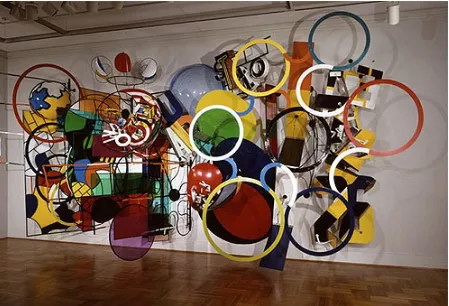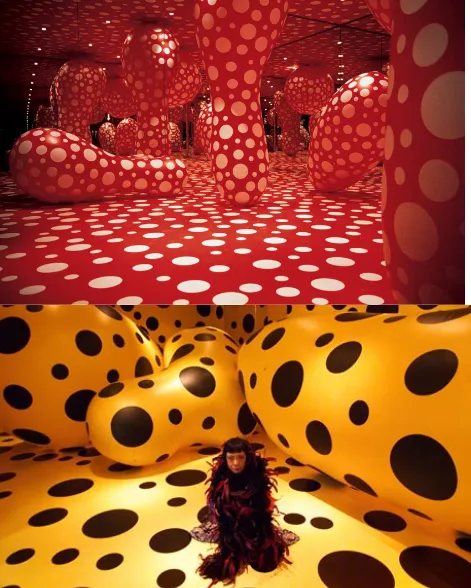My work is a personal and abstract visual interpretation touching on various
phenomenology and ideas surrounding addiction. The imagery is inspired by disease and rapidly forming infestations in nature. Moreover, the concept plays on the ideas of being human and being captivated by a visceral, elusive force. Bill Wilson, in the 1935 text of Alcoholics Anonymous, encourages the addict to “remember we deal with Alcohol [addiction], cunning, baffling, powerful.” (58) I seek to visually express the power and energy that lie behind such forces in my work. The work remains predominantly void of directly recognizable subject matter, leaving interpretation open to each viewer, who may or may not have any previous experiences with addiction. Negative interpretations of the concept might provoke ideas of greed, lust, and other obsessions, whereas, converse translations could recall positive energies including love, enamor, and spiritual atonement.
microscopes. I am attracted to the expressions found on circular shapes because the energy of the work can flow freely, never getting caught up in corners. Each painting, or “cell,” is
sometimes part of a larger installation that draws its placement from nature and the formations of molds, necrosis, or other rapidly reproducing growths that involuntarily spread, but are presented in an artful, almost playful manner. I seek to convey the excessiveness and paralyzing obsession often attributed with addiction through multiplicity and encompassing installations.
The painting process employed is often experimental, involving a combustion method, which is sometimes unpredictable. Encaustic is sandwiched lightly between layers of shellac that have been colored using aniline dye, denatured alcohol, and various inks. Although nature and the hands of the individual equally generate the final product, the process still seems to generate a feeling of Zen, being centered, and provides a sense of transcendence into vast realms of internal consciousness. Furthermore, the fluctuating nature of the media relates to the unstable loss of control and euphoria the addict experiences while the consumption of drugs, food, alcohol or other substances is taking place. I find myself lost in the work in a similar way that I have found myself lost in an altered psychological state, induced by a substance, sexual encounter, or other indulgence.
Critical Foundation
“What we call spirit exists by virtue of itself, a flame that fuels itself. However, because as something existing, it is opposed by Being, the spirit is consequently nothing but an addiction to such Being, just as the flame is addicted to matter. The most base form of the spirit is therefore an addiction, a desire, a lust.” (Clark, 8) Theories have seemed to move over time, from the theorist, into the hands of the medical doctor, and further into the heads of the psychologist.
In 1956, the American Medical Association began to consider alcoholism as a chronic illness. “Then came the idea that addiction is a disease: a medical illness like tuberculosis, diabetes or Alzheimer’s disease.” (Dodes) From this, the ideas surrounding addiction as a disease neutralized the public’s perception surrounding addiction and dissolved the “bad guy” stigma often surrounding those suffering from addictions. “The ‘disease concept’ is taught in addiction training programs and told to patients in treatment programs. But is it true? And if it is not true, is there a better and more helpful way to define addiction?” (Dodes)
Dr. Lance Dodes, in his article, “The Heart of Addiction,” from Psychology Today,
There is also some questioning that surrounding the ideas of visual stimulation, or “triggers,” that can be causation of a generated psychological response.
the common denominator of a wide range of addictive substances is their ability to cause psychomotor activation. This view is related to the theory that all positive reinforcers activate a common biological mechanism associated with approach behaviors and that this
mechanism has as one of its components dopaminergic fibers that project up the medial forebrain bundle from the midbrain to limbic and cortical regions. (Wise)
This psychological response is much like the effects that Art itself can “trigger” on the individual. The parallel can therefore be drawn between the individual viewer responding to Art (acting as the primary visual stimulus) and the addict responding to the visual trigger. “The addict’s craving…is not a rational assessment or choice of any sort, but basically an irrational compulsion arising from the repetition of a sequence of experiences in a process like that which leads to a conditioned response.” (Weinberg, 154) The effect the addict experiences is felt deeply, inducing a wild, bewildering emotional demeanor, causing a temporary paralysis in rational behavior, inability to distinguish right from wrong, and a dream-like euphoria. “The first area of our visual cortex to receive input from our eyes is called the primary visual cortex. It was once thought that neurons in this area respond almost exclusively to stimuli coming from the eyes. But we now know that the activity of these neurons is affected by “higher” brain centers which are involved in prediction and planning.” (Barry, 1)
Historical Foundation
In order to generate the similar warped psychological state the addict experiences through Art, immersive installations are key.
of the fact that these pieces are large enough for us to enter them—our experience is markedly different from that of traditional painting and sculpture. Instead of representing texture, space, light and so on, installation art presents these elements directly or us to experience. This introduces an emphasis on sensory immediacy, on physical participation. (Bishop, 11)
Artist Ilya Kabakov referred to this “type of work as a ‘total installation’ because it presents an immersive scene into which the viewer enters.”
Although installation did not become a popular form of artistic expression until the 1960s, the beginnings of installation art can be traced back to the early part of the twentieth century. “Sigmund Freud’s writings were fundamental to Surrealism, and the 1938 International
Surrealist Exhibition is paradigmatic for the type of installation art” that “plunges the viewer into a psychologically absorptive, dream-like environment.” (Bishop,10) In Freud’s The
Interpretation of Dreams, the psychoanalytic definition of a dream includes three main
characteristics, which include a first, primarily visual, which might contain auditory elements, a second, composite structure, that may seem nonsensical until broken down into elements, and a third, the ability of “each element to be replaced with an associative word or syllable.” (Bishop 16) Similarly, my work presents a number of visual images, textures, and auditory elements, which I generate as associations to theories surrounding addiction, but not directly recognizable, thus providing the viewer with visual cues that provoke their own analysis for self-interpretation.
“The 1938 International Surrealist Exhibition has become an oft-cited precursor of
Contributions by Man Ray, Salvador Dali, Georges Hugnet and Benjamin Peret played an equally important role. Under the direction of Marcel Duchamp as overall producer (generateur-aritre), the installation’s complex realization was an unquestionably collaborative venture.” (Bishop)
Judy Pfaff, a sculpture and installation artist in the early emerging in the 1960s, explores the ideas of excessiveness in her work. She combines painting, architecture, and installation into vibrant sculptures that seem to blur the lines of distinction between 2D and 3D work. The excessive repetition-- of bright colored circular forms jutting and sprawling on welded (pencil rod) structures from the gallery walls--directly engage the viewer in an almost confrontational manner. This same confrontational, no escape, subjection to imagery is the intention of my work. Similarly, “Pfaff as a Marxist painter and Modern artist uses her artwork as a way of showing control and expressing social commentary.” (Gallagher 1) But, she “allows the public to take control over what ever meaning they want to give to her installation. Her installations are never obvious, therefore the public is free to think whatever they want.” (Gallagher, )
Contemporary Peers
In a contemporary setting, my work possesses a great deal of similarity to the paper creations of artist Charles Clary. Clary “creates a world of fiction that challenges the viewer to suspend disbelief and venture into a fabricated reality.” (Clary) He builds “intriguing land formations that mimic viral colonies and concentric sound waves.” (Clary) The constructions “question the notion of viral outbreaks, transforming it into something more playful and inviting.” His
influence is extended by the fact that each piece is composed of elements that can stand alone as a single piece of art or act as a component to a larger work, such as an installation.
In addition, Pippilotti Rist uses video film and projections to engulf the viewer into other worldly installations composed of objective and non-objective abstract moving images. Her imagery is fluid and hypnotic, often moving from microcosms—including humans and nature— to macrocosms, like galaxies and astral bodies. My work could be attributed to any of these artists: Yayoi Kusama, for the psychosomatic, obsessive qualities and repetition of circles; Charles Clary, in the subjective realities based on various spreading growths and relations to nature as well as the playful approach; Pippilotti Rist, for the encompassing spaces of which viewers become a part; and to Pfaff and in their excessive qualities.
Trigger in Red. Oil, encaustic, aniline dye, shellac.
Trigger in Orange and Blue. Oil, encaustic, aniline dye, shellac.
With so much confusion and conflict in theory surrounding the phenomenology of addiction theory, this work conveys a visual explanation into the world that the addict experiences. Furthermore, it invites viewers to suspend their beliefs for a short while and renegotiate what is seductive and beautiful. Things that start out small, like a taste of something sweet, can slyly introduce the urge to the individual to try more. Visualizations, memory, and physical circumstance can trigger the individual to sample more, and over no specific designated period of time, an attraction develops. Attraction can further develop and lead to obsession, and soon, without much thought or intention, the individual has developed an addiction and is
encompassed by a drive and need to experience, indulge, use, or feed on that addiction. The intent of the work is to provoke new thoughts or investigations into addiction psychology and to generate a heightened visually stimulating experience that forces viewers to question our
Works Cited
Clary, Charles. Artist Statment (n.d.): n. pag. Diana Lowenstein Fine Arts Gallery. Web. 07 Nov. 2013.
Dodes, Lance. "Is Addiction Really a Disease?" Psychology Today. N.p., 17 Dec. 2011. Web. Wise, Roy A., and Michael A. Bozarth. "A Psychomotor Stimulant Theory of
Addiction." Psychological Review 94.4 (1987): 469-92. Print.
Weinberg, Darin, “Lindesmith on Addiction: A Critical History of a Classic Theory,” Sociological Theory. Vol. 15, No. 2. (Jul., 1997), pp. 150-161.

